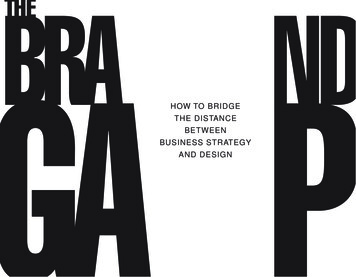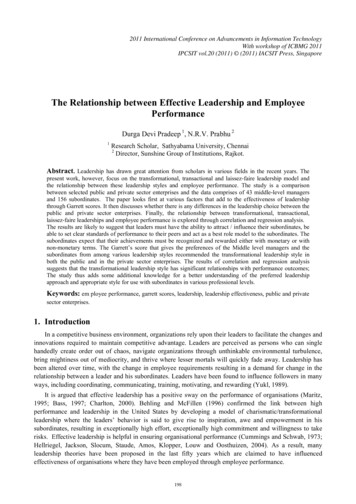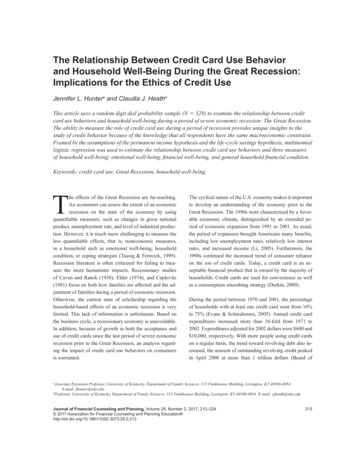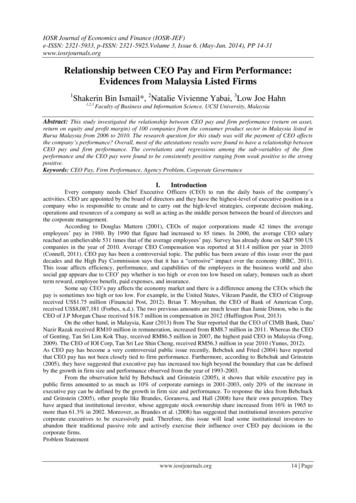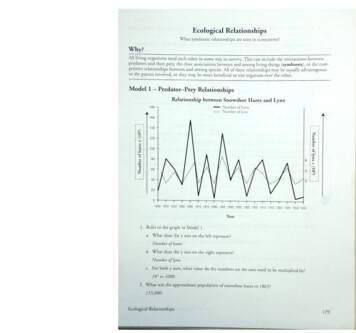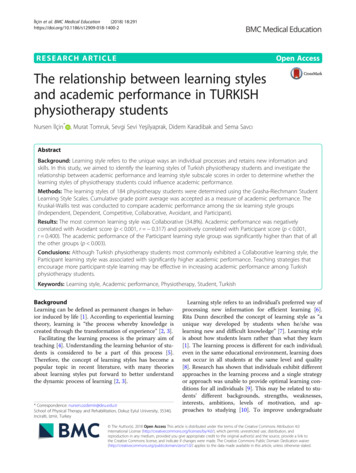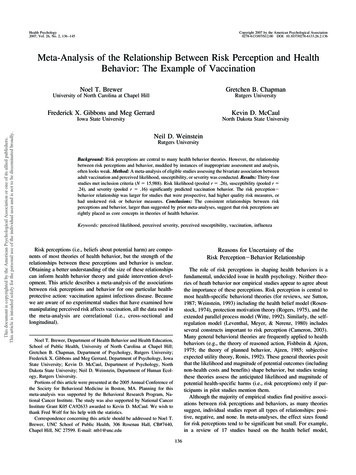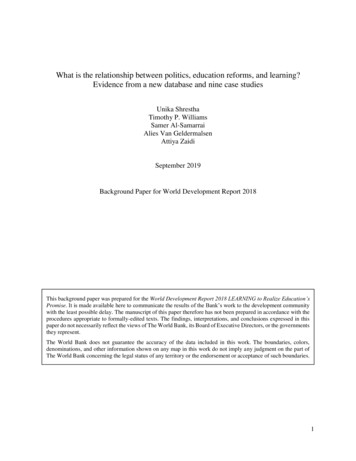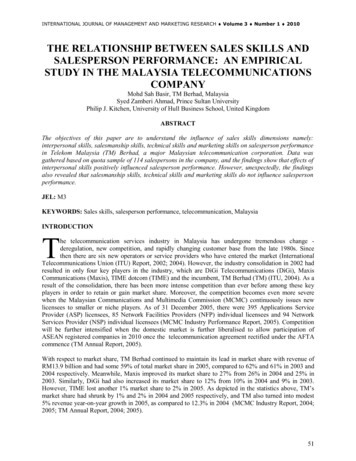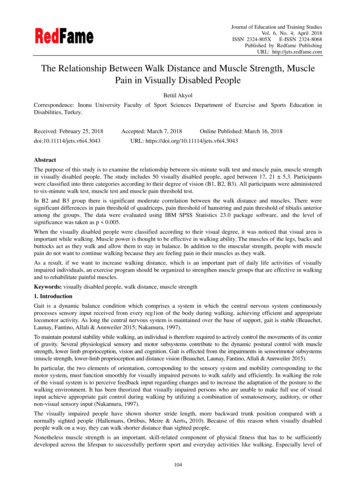
Transcription
Journal of Education and Training StudiesVol. 6, No. 4; April 2018ISSN 2324-805X E-ISSN 2324-8068Published by Redfame PublishingURL: http://jets.redfame.comThe Relationship Between Walk Distance and Muscle Strength, MusclePain in Visually Disabled PeopleBetül AkyolCorrespondence: Inonu University Faculty of Sport Sciences Department of Exercise and Sports Education inDisabilities, Turkey.Received: February 25, 2018doi:10.11114/jets.v6i4.3043Accepted: March 7, 2018Online Published: March 16, 2018URL: https://doi.org/10.11114/jets.v6i4.3043AbstractThe purpose of this study is to examine the relationship between six-minute walk test and muscle pain, muscle strengthin visually disabled people. The study includes 50 visually disabled people, aged between 17, 21 5,3. Participantswere classified into three categories according to their degree of vision (B1, B2, B3). All participants were administeredto six-minute walk test, muscle test and muscle pain threshold test.In B2 and B3 group there is significant moderate correlation between the walk distance and muscles. There weresignificant differences in pain threshold of quadriceps, pain threshold of hamstring and pain threshold of tibialis anterioramong the groups. The data were evaluated using IBM SPSS Statistics 23.0 package software, and the level ofsignificance was taken as p 0.005.When the visually disabled people were classified according to their visual degree, it was noticed that visual area isimportant while walking. Muscle power is thought to be effective in walking ability. The muscles of the legs, backs andbuttocks act as they walk and allow them to stay in balance. In addition to the muscular strength, people with musclepain do not want to continue walking because they are feeling pain in their muscles as they walk.As a result, if we want to increase walking distance, which is an important part of daily life activities of visuallyimpaired individuals, an exercise program should be organized to strengthen muscle groups that are effective in walkingand to rehabilitate painful muscles.Keywords: visually disabled people, walk distance, muscle strength1. IntroductionGait is a dynamic balance condition which comprises a system in which the central nervous system continuouslyprocesses sensory input received from every reg1ion of the body during walking, achieving efficient and appropriatelocomotor activity. As long the central nervous system is maintained over the base of support, gait is stable (Beauchet,Launay, Fantino, Allali & Annweiler 2015; Nakamura, 1997).To maintain postural stability while walking, an individual is therefore required to actively control the movements of its centerof gravity. Several physiological sensory and motor subsystems contribute to the dynamic postural control with musclestrength, lower limb proprioception, vision and cognition. Gait is effected from the impairments in sensorimotor subsystems(muscle strength, lower-limb proprioception and distance vision (Beauchet, Launay, Fantino, Allali & Annweiler 2015).In particular, the two elements of orientation, corresponding to the sensory system and mobility corresponding to themotor system, must function smoothly for visually impaired persons to walk safely and efficiently. In walking the roleof the visual system is to perceive feedback input regarding changes and to increase the adaptation of the posture to thewalking environment. It has been theorized that visually impaired persons who are unable to make full use of visualinput achieve appropriate gait control during walking by utilizing a combination of somatosensory, auditory, or othernon-visual sensory input (Nakamura, 1997).The visually impaired people have shown shorter stride length, more backward trunk position compared with anormally sighted people (Hallemans, Ortibus, Meire & Aerts, 2010). Because of this reason when visually disabledpeople walk on a way, they can walk shorter distance than sighted people.Nonetheless muscle strength is an important, skill-related component of physical fitness that has to be sufficientlydeveloped across the lifespan to successfully perform sport and everyday activities like walking. Especially level of104
Journal of Education and Training StudiesVol. 6, No. 4; April 2018lower extremity muscle strength is required for people’s gait ability (Muehlbauer, Gollhofer & Granacher, 2015). Trunkmuscle strength and abdominal muscle strength are important for mobility. Decreased flexor and extensor trunk musclestrength, reduced spinal mobility, in such a case, cause low back pain and leg pain in people. Such pain reduces walkingability that is a daily function (Durmus, Durmaz & Canturk, 2010).Painful conditions of the back pain, leg pain cause some changes in walking. Lower velocity and shorter steps, shorterduration of the stance phase on the painful side is observed. Other changes in gait patterns can be induced by jointswelling and muscle weakness (Perry, 1992).Depending on underlying causes can be difficult to determine the pain in the body caused by low force implementationapart from the sensitivity to pain. With pressure pain thresholdand sensitivity level monitoring, underlying problems, pain levels, improvement speed and level can be followed(Akyol , Arslan & Çolak, 2016).The six-minute walk test is routinely used to assess the functional walking ability of people and evaluate functionalcapacity in daily activities. The 6 six-minute walk test is used to measure the maximum distance that a person can walkin 6 minutes. The primary measurement is the total distance walked. Walk distance is effected from personal ability,physical position, and visual ability. The shorter the pace of walking in six minutes is because short people have shorterstep lengths. Older and heavier subjects usually have reduced muscle mass and therefore, shorter 6 six minute walk test,as do those who are less motivated or have impaired cognition. Because of 6 six minute walk test is used to assess thefunctional walking ability of people, tests may be helpful to yield up people’s pulmonary function, cardiac function, ,muscle strength, visual ability and cognitive function (Enright., 2003; Reis, Gustavo, Costa, Schmidt, Ferreira& Abreu1,2012; Pradon, Roche, Enette & Zory, 2013; Steffen, Hacker & Mollinger , 2002).For all these reasons, we want to assess the relation between walk distance and muscle strength, muscle pain withvisually disabled people.2. MethodsA total of 50 visually disabled people (30 males, 20 females; age 17,21 5,3.years, weight 53.73 kg 11.12 kg, height1.62 m 0.177 m standard deviation) participated in this study. The International Blind Sports Association (ISBA)uses a three-class system to classify persons who are blind or visually impaired. All classifications are in the better eyewith best correction. (ISBA handbook, 1993).B1: From no light perception at all in either eye up to and including theability to perceive light, with the inability to recognize objects or contours in any direction and at any distance. B2:Ability to recognize objects or contours up to a distance of 2 meters that a person with normal vision can see at 60meters (i.e. below 2/60 vision) and/or field of vision less than 5 degrees B3: Can recognize objects or contours between2 and 6 meters away that a person with nonnal vision can see at 60 meters (i.e. 2/60 to 6160 vision) and/or field ofvision between 5 and 20 degrees (Tepfer& Amanda, 2004).2.1 Six Minute Walk Test (6MWT)Each subject was instructed to walk as far as possible in 6 min (six minute walk test distance), at their own speed(Muehlbauer, Gollhofer & Granacher, 2015). Subjects walked lengths of a 30-m walking track marked by a cone at eachend, which they were instructed to walk around. The total distance covered in meters during the 6 min of walking wasused as the score for each session (Durmus, Durmaz & Canturk, 2010).2.2 Muscle TestAs part of the muscle test, we evaluated hip flexör muscles, hip extension muscles back extensors, abdominal musclesand anterior trunk flexors. Muscle testing was conducted according to Dr. Robert W. Lovett's (Otman, Demirel &Sade,1998) manual muscle testing method. This test comprises the following categories: Normal (5): muscle completes therange of motion with maximum resistance against gravity. Good (4): muscle completes its normal range of motion withresistance less than maximum resistance against gravity. Fair (3): muscle completes its normal range of motion againstgravity. Poor (2): muscle completes its normal range of motion in a position with gravity eliminated. Trace (1): palpablecontraction before disclosure of motion in the joint. Total paralysis (0): No muscle contraction is felt.2.3 Pain ThresholdPain threshold in the quadriceps femoris, hamstring and tibialis anterior muscles were determined with J-Tech digitalalgometer (J-Tech Medical Industries Algometer Commander). The applied force used for the calibration of the devicewas set to Newton (N). Each time the device is turned on, it automatically self-calibrates displaying zero. Themeasurement of muscle pain threshold were measured with the 1 cm²probe tip.Measurements were repeated three times at 5-second intervals and the average values were recorded. Each evaluationwas applied in relaxation position. The participants were asked to say "Yes" each time they felt pain in each contact.105
Journal of Education and Training StudiesVol. 6, No. 4; April 2018Each time the patients said "Yes," the device was held back for 5 seconds to provide relief; the second and thirdmeasurements from the same spot were then carried out after the relaxation period (Lydia, Roberto & Fil 2012; Özer,2002). Pain threshold measurements were recorded twice for each participant for each region.3. ResultsPower analysis suggested at least 10 individuals in each group with the . difference of the groups of 8.57, standarddeviation of 5.5, type I error of 0.05 and type II error of 0.20 (Hintze, 2011). The data were expressed as either median(min-max) values or mean (standard deviation, SD) depending upon overall variable distribution. Normality wasassessed using Shapiro Wilk test. The normally distributed data were analyzed by one-way ANOVA followed byBonferroni or Tamhane T2 post-hoc test. Correlations were estimated using Pearson correlation coefficient asappropriate. P 0.05 values were considered as significant. IBM SPSS statistics version 23.0 for Windows was used forstatistical analyses.Table 1. Demographic characteristics of ht Mean17.2153.7330.631.56Std. Deviation5.311.126.320.16Table 2. Mean and standard deviation of age variable for each groupsVariableAge (mean SD)GroupB1(n 11)18.24 (3.51)B2(n 19)16.31 (4.07)B3(n 20)15.12 (4.14)Table 3. Correlations of walk distance and istanceB1WalkdistanceB3B2r 0.244p 0.446r 0.259p 0.257Lateraltrunkflexorsr 0.060p 0.853r 0.466*p 0.033AnteriorTrunkflexorsr 0.127p 0.694r 0.398p 0.074Lowerabdominalobliqsr 0.470p 0.123r 0.533p 0.013r 0.391p 0.053r 0.456*p 0.022r 0.490*p 0.013r 0.659**p sionr 0.095p 0.769r 0.560**p 0.008r 0.348p 0.088r 0.095p 0.769r 0.571**p 0.002r 0.095p 0.769r 0.470*p 0.032r -0.064p 0.842r 0.496*p 0.022r 0.348p 0.088r 0.255p 0.219r 0.396*p 0.050In B2 group there was significant moderate correlation between walk distance and hip flexor muscles (Pearsoncorrelation 0.560; p 0,008).In B2 group there was significant moderate correlation between walk distance and lower abdominal muscles (Pearsoncorrelation 0.533; p 0,013).In B2 group there was significant moderate correlation between walk distance and hip extension muscles (Pearsoncorrelation 0.571; p 0,002).In B3 group there was significant moderate correlation between walk distance and anterior trunk flexor muscles(Pearson correlation 0.490; p 0,013).In B3 group there was nearly significant high correlation between walk distance and lower abdominal oblique muscles(Pearson correlation 0.659; p 0,001).Table 4. Mean and standard deviation of pain threshold muscles and walk distance for each groupsGroupB1 (n 11)VariablesB2 (n 19)MeanStandard Deviation MeanWalk distance513,3390,79Pain threshold of quadricepsPain threshold of hamstringB3 (n 20)Standard Deviation MeanStandard Deviation P600,00 163,62605,20 175,290,22318,45*# 4,1923,624,5627,026,96 0,00116,26#4,2721,054,4924,947,03 0,001Pain threshold of tibialis anterior 12,91#3,7116,68# 4,9520,626,30 0,001*: significantly different from B2; #: significantly different from B3;106
Journal of Education and Training StudiesVol. 6, No. 4; April 2018There were significant differences in pain threshold of quadriceps, pain threshold of hamstring and pain threshold oftibialis anterior among the groups. In relation to pain threshold of quadriceps, the mean of B1 was significantly differentfrom B2 and B3 (p 0,05); whereas the mean of B2 was not significantly different from B3 (p 0,05). For pain thresholdof hamstring, the mean of the B1 was significantly different from B3 (p 0,05). The B3 mean of pain threshold oftibialis anterior was significantly different from B1 and B2 (p 0,05).Table 5. Relationship between walking distance and muscle strength according to visual degreeWalk distanceVisualDegreeB1Walk distanceB2Walk distanceB3Quadriceps femorisHamstringTibialis anteriorr -0.078p 0.81r 0.326p 0.149r 0.645p 0.001r 0.243p 0.447r 0.394p 0.077r 0,605p 0.001r -0.338p 0.282r 0.348p 0.123r 0.598p 0.002There were positive relationships between walking distance and quadriceps femoris, hamstring and tibialis anterior.In B2 group there was significant moderate correlation between walk distance and hip flexor muscles, lower abdominalmuscles and hip extension muscles.In B3 group there was significant moderate correlation between walk distance and anterior trunk flexor muscles andthere was nearly significant high correlation between walk distance and lower abdominal oblique muscles.There were significant differences in pain threshold of quadriceps, pain threshold of hamstring and pain threshold oftibialis anterior among the groups. In relation to pain threshold of quadriceps, the mean of B1 was significantly differentfrom B2 and B3, whereas the mean of B2 was not significantly different from B3. For pain threshold of hamstring, themean of B1 was significantly different from B3. B3 mean of pain threshold of tibialis anterior was significantlydifferent from B1 and B2.When people move, visual area is important. If the visual area is wide people can move smoothly and safely. When wewalk we use our visual input and muscles. For a full gait, coordination must be between muscles and visual input.Visual impairment, decreased muscle strength and pain on the muscles affect walking in the negative direction. Visuallydisabled people have partial visual area on eyes and they worry to fall down while walking.Just because of this they walk slowly and they cannot take long distance when they walk. If people have pain on musclethey don’t want to carry on walk. Because walking is limited by pain. In addition to visual impairment, muscle strengthand muscle pain problems can effect walking and walk distance on people who have visual impairment.For all these reasons, if we want to develop walking ability which is a part of life in visual people, firstly we shouldconsider exercise programme according to muscle groups that are effective in walking and that are less painful. Whenwe develop muscles strength and decrease muscles pain, these people can walk in safety and they can take long distancewithout falling down in daily life. So that we can make these people more independent in their daily lives and give themcommunity.4. DiscussionThe aim of this study was to determine, in visually disabled people whether or not muscle strength and muscle painthreshold were related to 6MWT (six minute walk test) performance. The results of this study since 6MWTperformance was significantly correlated with the muscle strength because in B2 group there is significant moderatecorrelation between walk distance and hip flexor muscles, lower abdominal muscles, hip extension muscles. In B3group there is significant moderate correlation between walk distance and anterior trunk flexor muscles and there isnearly significant high correlation between walk distance and lower abdominal oblique muscles. Muscles strengtheningimprove performance of walking (Chetta , Zanini , Pisi , Aiello , Tzani & Neri, 2006). Camarri et al. suggests that healthproblems and plantar flexor strength have a great influence on six minute walk distance (Chetta , Zanini , Pisi , Aiello ,Tzani & Neri, 2006).Landers et al. cited that the reduction in leg muscles strength is one of the causes of poor performance in activities suchas walking, sitting/standing, which in turn may interfere with the performance in the walk test (Landers, Hunter,Wetzstein, Bamman & Weinsier, 2001).Hip abductor muscle weakness results in impaired pelvic control during gait. Muscles in a fatigued state may behavelike weak muscles as they experience a reduced ability to produce force. Reduction in force production, either fromweak or fatigued muscles, limits the body’s ability to attenuate the high forces associated with dynamic movements(Singha, Pattnaikb , Mohantyb & Ganeshb, 2016). It can be thought that muscle strength can affect walking ability.107
Journal of Education and Training StudiesVol. 6, No. 4; April 2018While walking lower extremity muscles, hip muscles are active and these muscles facilitate to stay on balance. Sopeople can walk long distance without falling down. Shreya et al. showed that hip abductor muscle strengthening canreduce knee load and improve pain and physical function in people (Singha, Pattnaikb , Mohantyb & Ganeshb, 2016).In this study, it is seen that there is significant correlation between walk distance and hip flexor muscles, lowerabdominal muscles, hip extension muscles, lower abdominal oblique muscles. Based on this context, a musclestrengthening protocol may improve performance in the 6MWT, thus increasing the distance walked (Reis, Gustavo,Costa, Schmidt, Ferreira& Abreu1, 2012).The aging process promotes a gradual decrease in both muscle mass and muscle strength, with an estimated 5% loss inmuscle mass every decade after age 40 affecting mainly the lower limbs (Reis, Gustavo, Costa, Schmidt, Ferreira&Abreu1, 2012).This study’s average age is 14, 31 4, 1. This is an advantage in this study because there is no muscle mass problem inpeople who are participate in the study.As the visual capacity increases, the walking distance of people seems to increase. When visual people are classifiedinto their visually degree there was seen that the muscles that related to walk distance were different from each other. Inorder that visual area is important for visually impaired people who worry to fall down while walking. Just because ofthis they walk slowly and they can’t take long distance when they walk.For a people with visual sensory disabilities, the most difficulty is to give to his gesture an expendable space through adifferent motory idea. It is important that those people listen to the changes of the motory inputs, using useful stimuliwhich promote his learning and his discovery of the space around (Bellomo, Barassp, Pancrazio & Sagginp, 2012).They learn, with different times and rates, to use the surrounding space and its different forms and can relate to it withthe help and the voice of other people around (Eimer, 2004; Rösler & Bötting, 2004).Bellomo et al. indicated that if balance and muscle control can be increased in visually sensory disabled people, itwould be good improvement of the painful-dysfunctional situation, improvement of the quality of life in the subjects.They indicated that it
The data were evaluated using IBM SPSS Statistics 23.0 package software, and the level of significance was taken as p 0.005. When the visually disabled people were classified according to their visual degree, it was noticed that visual area is important while walking. Mu
